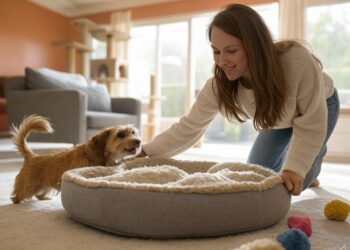Running with the dog can be very enjoyable for both you and your dog. To ensure that jogging remains enjoyable for both of you, it is important to prepare well. With the tips in this blog, you will walk together as a team!
Running with the dog
Running with your dog keeps both healthy and active. In addition to being healthy, it can also be very satisfying for both. Are you a sporty type yourself and is your dog also suitable for this? Then running with your dog is definitely worth a try. In the blog below, we explain how you can best run with your dog. But also what you should think about before you start running with your dog.
Can my dog run?
Before you start running with your dog, it is important to first carefully consider whether your dog is suitable for this. There are dog breeds, that are not suitable for walking long distances due to their body size. Small dogs or dogs with short legs are more fun with short walks at a slow pace. But also the very large or heavy dogs are not really suitable for the intensive effort of running.
On the other hand, your dog may look healthy, but what about your lungs, heart, or joints? You can easily pay a visit to your vet to rule out any problems. When your dog is fit for running, and of course you, too, a running routine can start.
Am I ready to go running with my dog?
Now that you know that your dog is suitable for running, you can also prepare yourself for this. You have purchased good running shoes and wanted a sporty outfit. What else do you need to bring with you? Your dog, of course, speaks for itself. Running your dog lose while running is quite awkward.
Your dog can go in all directions or walks past your feet and you are ultimately more energetic with your dog than with running. So it’s best to take your dog on a leash. However, it is rather awkward to constantly have to hold a leash with one hand while running with your dog. That is why a good solution is a hip belt. This way you have both hands free.

Why is a hip belt handy while running with a dog?
If your dog starts pulling you can even have a shoulder injury. It is much nicer to have both hands free when you are running with your dog. You can purchase a special running belt with a hip belt for this. With a hip belt around your waist, you yourself are many times more stable and you have both hands free.
Attach the dog’s strap to the lap belt. You then attach this leash to the collar or dog harness of your dog. Most running belts spring slightly with the possible pulling of your dog and are also partly elastic to give your dog more freedom of movement while running.
Build up step by step
If your dog is fit for running and you have made all the preparations you can start. If you have been running for a while, you cannot expect your dog to be immediately at the same level as you.
To allow your dog to get used to running, it is wise to run small distances several times a week. This way your dog can get used to running and you can see if he likes it. If your dog likes it, you can extend the distance a little every time.
Where can you easily run with a dog?
For the dog, it is better if a large part of the route has a soft surface. If you walk around 1 or 2 km with your dog once a week, you can, of course, do that on the bike path. If you go running for 10 km every morning, we recommend that you choose a forest path or, for example, a beach.
Your dog, unlike you, has no flexible shoes. Walking on a hard surface can be very stressful for the joints. Therefore, preferably walk on a soft surface, for example in the forest or through fields. If possible, have your dog walk on the grass side when you walk on hard surfaces.
While running
If you are running with your dog and you have the speed, pay attention to how your dog responds. Can your dog keep up the speed, do you have enough water for your dog? These are important things to look out for when you go running with your pup.
To ensure that your dog gets enough water, it is wise to bring a drinking bottle. If your dog does not drink enough, it can lead to overheating. It is also a good idea to bring a poop bag. If your dog suddenly has to do his needs, you can clean up his dog poop immediately.
Create distance
While running you will also have to take other road users into account while you are running. If you come across cyclists, other joggers, walkers or other owners with dogs, move away if possible and create distance and space for your dog when passing. If you do that consistently, your dog will respond calmly to such movements.
Take breaks
For long distances, take a few breaks so that your dog can relax. Use this time yourself to do your stretching exercises. In the meantime, your dog can drink a little water, browse around and do the need. When both of you are back on your breath you can continue running again.

After running with your dog
Don’t forget to check his fitness after running. How are your dog’s footpads? And also check between the toes if there are no stones, glass fragments or other problems.
The most important thing after running with your dog is that you ensure that he can drink enough water. A dog cools itself with this, which lowers body temperature. In addition, your dog would like to rest and not immediately want to come and visit again. Certainly, do not run every day with your dog but take enough rest days to be able to recover.
Give him rewards
Take tasty rewards for your dog with you to ensure that your dog pays attention to you when needed. Use small training cookies that your dog does not have to chew on for too long. Also, realize that many dogs are less likely to respond to your command when they get tired.
Leave your earplugs with music at home so that your attention is fully focused and you can hear the surroundings well. Take a cell phone with you so that you can get help if something is wrong.








